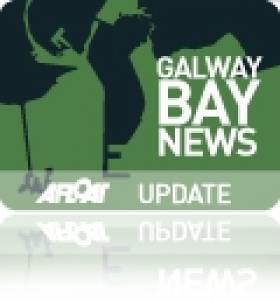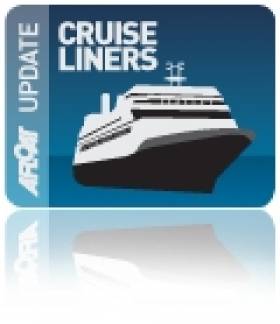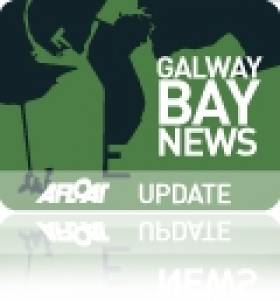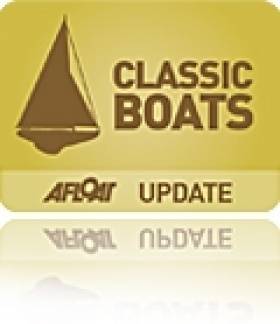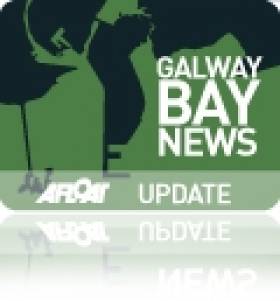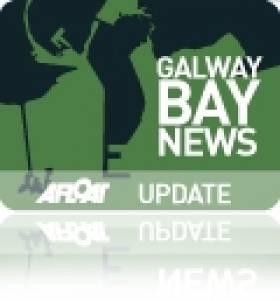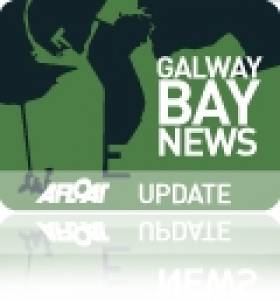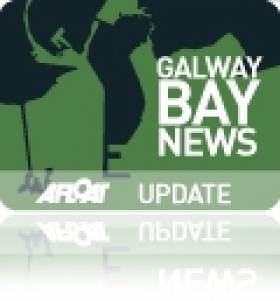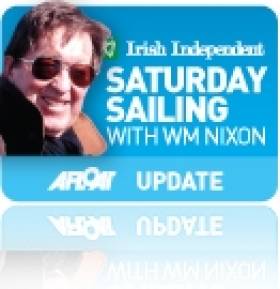Displaying items by tag: Galway Harbour
Galway Port Expansion Plans Face Environmental Hurdle
#GalwayPort - Parts of the current expansion plan for Galway Harbour would have a significant adverse impact on Galway Bay, according to An Bord Pleanála - a week ahead of the expected decision that has already been delayed for many months.
As RTÉ News reports, the planning body has invited the Galway Harbour Company to suggest moves it can make to offset any lasting damage to habitats in what is a candidate for designation as a Special Area of Conservation.
It has been confirmed that the €126 million redevelopment scheme, which involves reclaiming 24 hectares from the sea, would destroy a number of reef, mud and sand habitats.
Pending that feedback, planners will then decide whether to refer the expansion scheme to Brussels under the Derogation of the Habitats Directive for projects of overriding public interest.
Galway Harbour Hearings Roundup: Mayor Shows Full Support, Infrastructure Questioned, Alternatives Proposed
#GalwayHarbour - Galway's mayor reiterated his full support for plans to redevelop the city's port on the final day of An Bord Pleanála's hearing into the €126 million scheme.
As The Irish Times reported last weekend, Mayor Donal Lyons said the port expansion was vital for the future of the city, echoing claims that Galway Harbour could face terminal decline unless the redevelopment goes ahead as planned.
The potential economic benefits were raised by Esmond Keane SC, on behalf of the Galway Harbour Company, who said "it is not feasible to suggest that cruise tourism could be relocated to another port away from Galway."
Ian Lumley of An Taisce made a final submission questioning the wisdom of developing a new port that "lacks connection" to the national road transport infrastructure.
The Shannon Foynes Port Company also dismissed claims that there were no viable alternatives to the expansion, citing its own status as a 'Tier 1' deepwater commercial port that operates on a 24-hour basis compared to Galway's more modest plans.
That came after Galway West TD Noel Grealish's earlier rejection of Shannon Foynes' objections as "spurious" and motivated by "self-interest".
Previously the hearing also heard from town planner Aiden O’Neill, who said the Galway Harbour scheme went against a number of State policies such as the 2013 National Ports Policy.
"Long-standing" proposals for a deepwater quay at Rossaveal, on the north shore of Galway Bay in Connemara, were suggested as an alternative to bolster the current Galway Port, while fishing and cycling representatives expressed their various concerns over the impact of the redevelopment.
Two weeks of evidence will now be evaluated by An Bord Pleanála with a full report expected by the end of March. The Irish Times has more on the story HERE.
#CruiseLiners – Galway Harbour Company will welcome the fifth cruise caller this season when Holland America Line's Prinsendam calls this day next week, writes Jehan Ashmore.
As previously reported, this season is one of the busiest in recent years for the mid-west port when eight calls are made and all by different operators. Due to their size, all cruiseships are to anchor offshore in Galway Bay.
The mid-sized cruiseship at 37,000 tonnes is capable of carrying more than 800 passengers and she follows a history of HAL calling to Galway when regular liner calls in 1939 reached 56 that year.
According to the port's website's cruiseliner list, the following other calls are by Crystal Cruises, Phoenix-Reisen and Club Med until the close of season in early September.
Buildings Evacuated Over Galway Harbour Trawler Fire
#TrawlerFire - RTÉ News is reporting on a fire on a fishing trawler in Galway Harbour that's prompted the precautionary evacuation of buildings in the area.
Though the fire has been put out by emergency services, there is some concern about a container of gas used as fuel for welding work on board the vessel.
RTÉ News has much more on the story, including video, HERE.
#NaomÉanna- According to Galway Bay FM, Galway Port Company said it would be happy to provide a permanent home for an old ferry, Naom Éanna, which once linked Galway to the Aran Islands.
The port's harbourmaster, Captain Brian Sheridan says Galway docks would be an ideal location for the Naomh Éanna as a tourist attraction.
Gaeltacht Minister Jimmy Deenihan has put a stay on scrapping the Naomh Eanna until the end of March.
The vessel has been housed at Dublin's Grand Canal, but a proposal was put forward to scrap it, which is being opposed by the Inland Waterways Association of Ireland and other maritime groups.
Among the campaigning groups are the Naomh Éanna Trust's SOS Save Our Ship which in co-operation with Sam Field-Corbett of the Irish Ship & Barge Fabrication Co, are hoping for funding from private investors, so to save the vessel from scrapping by Waterways Ireland.
Due to the reprieve date of less than four-weeks to go this month, Stephen Payne of the Naomh Eanna Trust also speaking to Galway Bay FM, has said that the IS&BF would not be able to secure a berth for her in the Dublin Port for at least the next two years.
It is proposed instead to sail the vessel under own steam to Galway Port, this would involve spending €180,000 to bring her to a seaworthy state. Mr. Payne added the engines were in working order.
To completely carry out a full restoration to her former glory would be in the region of €1.8m to €2m.
Afloat.ie adds that the trust's SOS Save Our Ship campaign's online petition to save the heritage ship at time of posting stands at more than 300 signatures.
#galwayharbour – The Galway Harbour Company will today lodge a planning application with An Bórd Pleanála to significantly expand its existing footprint.
Current Port capacity is seriously inadequate if it is to compete for, and win, new national and international business. Indeed, current facilities are no longer sufficient to meet the changing needs of its existing customers. The expansion of the Port will ensure the creation of a revitalised hub in the heart of Galway city, providing additional employment and enhancing the economic contribution being made by the Port to Galway city and its environs.
The Port of Galway is facing today's market challenges head on by developing an exciting expansion programme which will radically transform the way it operates. The 27 hectare extension project will be carried out over four stages, with construction on the first stage due to begin next year at a cost of €52 million. The remaining three stages of the expansion are due to be completed by the end of 2017.
In addition to the 252 people currently employed by the Port of Galway, 200 jobs will be created during the construction period, while the increased employment numbers post-development are expected to be in the order of 700/800 directly in the Port/Port Enterprise Park and offsite as a result of increased port traffic.
The Department of Transport, Tourism and Sport's National Ports Policy 2013, seeks to provide a clear strategic direction for the Irish Ports sector by developing a number of 'Ports of Regional Significance'. These are Ports that serve an important regional purpose and/or specialised trades or maritime tourism. The proposed expansion at Galway Port will allow it to develop its potential as a significant infrastructural asset for Galway, the Western region and beyond.
According to Eamon Bradshaw, CEO, Galway Harbour Company, "the expansion of the Port is critically important for the economic future of the entire Western Region. This proposal envisages the creation of a marine facility capable of ensuring that Galway has a harbour infrastructure fit for the twenty first century."
Endorsing the proposal, President of Galway Chamber of Commerce, Jim Fennell said "the extension of Galway Port and the upgrading of Port facilities is a top priority for Galway Chamber and is key to the development of our city and the wider region."
Anthony Ryan, Galway City Business Association, also welcomed today's announcement, "we see the extension of the harbour as a key infrastructural development for Galway. The potential for business growth for the city is enormous and will represent a critical piece of infrastructure for the city going forward."
This is the key to its future survival as a vibrant economic entity, thereby securing the Port's strategic development for future generations to come. Further information regarding the plans to extend the Port of Galway is available atwww.galwayharbour.com
Galway Harbour Plans 'Will Put City On Map For 800 Years'
#GalwayDocks - The planned expansion of Galway Harbour will put the City of the Tribes on the map for the next 800 years, according to Galway Harbour Company chair Paul Carey.
Galway Bay FM reports on Carey's grand statement made at a presentation to city councillors on Monday 9 September.
As reported last week on Afloat.ie, the finalised plans for the multi-million expansion and modernisation of the city's harbour and docks will be lodged with An Bord Pleanala before the end of September after the original deadline was pushed back several months.
First Test Flight For Galway Harbour Seaplane Service
#Seaplane - Almost 80 years after Charles Lindbergh considered the idea of a seaplane base in Galway Harbour, a Clare-based company has held its first test flight out of the city for a proposed new seaplane service, as RTÉ News reports.
The Cessna 206 was flown to and from the harbour yesterday (5 September) by Mountshannon-based Harbour Flights, which hopes to establish a permanent pontoon in the docks to run scenic excursions around Lough Derg and further along the west coast region next year.
It's also hoped that the tourist flights would pave the way for an Aran Islands commuter service, and an eventual Galway to Dublin route.
The plans come three years after Ireland's first ever commercial seaplane service ran its first test flights out of Cork Harbour.
RTÉ News has more on the story HERE.
The flagship event of the Galway Sea Festival is the Galway Bay Sailing Club Annual Regatta. The regatta which takes place from Friday evening through to Monday afternoon involves three days racing in Galway Bay. Founded in 1969 the Galway Bay Sailing Club is moving into the centre of Galway from its Rinville base for the Regatta which has been renamed the Galway Sea Festival Regatta in honour of the inaugural Galway Sea Festival. Galway Harbour and Marina will be awash with colour as they host the fleets of the Galway Bay Sailing Club and the Headquarters and Club House for the Regatta will be located in the Harbour Hotel for race registration, post race refreshments and the venue for prize giving ceremonies each evening.
The Galway Sea Festival Regatta is a significant event in the sailing calendar and the first major sailing competition of the 2013 season. An open competition boats from Clifden, Westport, Sligo and Kilrush are expected to take part with crews arriving from all over the country.
Prior to the start of racing on Friday evening 31st May the boats will be blessed at 6pm by Fr. Dick Lyng and the Rev Gary Hastings. After the blessing the first race of the regatta is a short coastal raced named the Harbour Hotel Coastal Race in honour of the new Club House for the Regatta. The race start will be off Mutton Island finishing at the Leverets and can be viewable from Salthill.
Following the conclusion of the Race the boats will congregate in the area of the Leverets before commencing what will be a colourful Parade of Sail into Galway Docks at approximately 8-9pm.
There are three races on Saturday 11am, 1pm and 3pm and two races on Sunday at 12pm and 2pm. The Galway Bay Sailing Club Junior and Accessible Sailing fleets take to the water on Sunday afternoon to welcome the racing fleets ashore and on Monday it's the turn of Dinghies with their regatta which will include the Galway Bay Sailing Club DART catamaran fleet which is the largest in Ireland.
Galway Bay Sailing Club Commodore Dave Vinnell says "Galway Bay Sailing Club is pleased to be an enthusiastic supporter of this the first Galway Sea Festival. As the main sailing club on the bay and one of the most active on the whole of the West Coast, GBSC has from the inception of the Galway Sea Festival, whole heartedly supported it as one of its partners."
The members, committee and Flag Officers of GBSC wish Galway Sea Festival a successful event, we are proud to be involved and intend having an exciting, enjoyable and entertaining Festival both on and off the water. It is our hope and expectation that the Festival becomes an annual event and continues to grow from year to year."
Prize giving will take place each night in the Harbour Hotel at approximately 10.30pm on Friday evening, 8,30pm on Saturday evening and 6.30pm on Monday evening. Regatta registration commences from 2pm on Friday 31st May.
General Manager of the Harbour Hotel Stefan Lundstrom said "It is great to have an event back in the harbour area after the huge success of the Volvo Ocean Race. We are delighted to be Headquarters of the Galway Bay Sailing Club Regatta and we look forward to welcoming all the sailors, skippers and public alike through our doors for great food, great craic and entertainment over the June Bank Holiday Weekend.'"
Galway Offshore Racer Achieves Perpetual Motion
"Harbour rots ships and ruins men". So said Horatio Nelson. He not only knew it from his own extensive command experience, but from time to time during long stays in port, he proved it personally with cringe-making results. He should have remembered that other saying of the sea: A busy ship is a happy ship. And at a more basic level, surveyors and boat maintenance experts will tell you the simple truth, that boats and their equipment usually don't get worn out, but they slowly rot through disuse.
With modern materials, it's not rot as they'd have known it in Nelson's day. But whatever you might call it, it makes things non-functional. Yet a boat which is on the move - sailing regularly and extensively - soon has everything working sweetly, for the demands of the sea are such that the attitude of "sure 'twill do" soon provides its own come-uppance.
Out in the west, they've an attractive boat which is making a fair bid to be a perpetual motion machine, with everything functioning smoothly. It's not that long ago that Martin Breen of Galway bought the Reflex 38 Lynx, but since then she has been in the frame in so many major offshore events, and under so many different sponsorship names, that you could be forgiven for thinking he's owned her for more than a decade, and that there are two or three different boats involved.
At the time he bought her, we noted that she seemed to be the ideal size of boat for Irish conditions. The First 40.7, globally the most successful production-built frontline offshore racer of the past twenty years and a super boat with it, is just that little bit too big for Irish conditions in terms of personnel demands and maintenance requirements. But if you go down to some of the hotter 36ft and 34ft machines, you often find you're missing the boat in terms of catching tidal patterns, and the basic realities of seagoing comfort, even though the brilliant J/109 frequently proves otherwise.
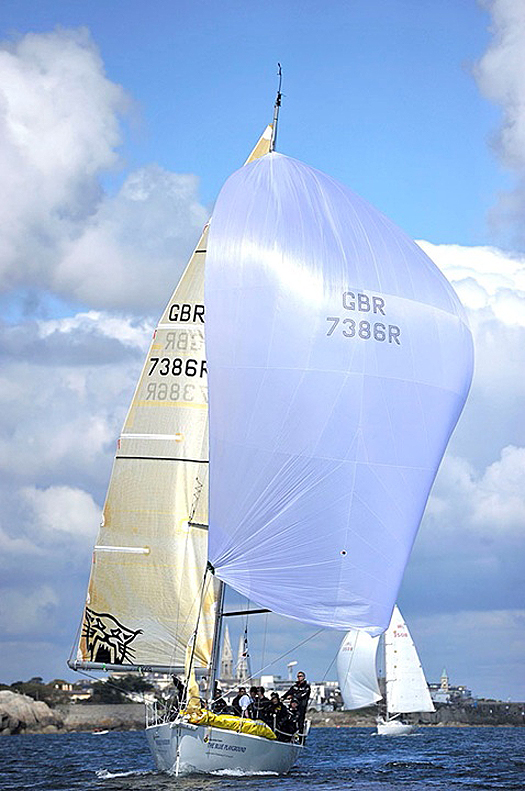
Settling in shortly after the start of the Dun Laoghaire to Dingle, 2011
But 38ft LOA - that is just spot on. When Christian Stimson created what is now the Reflex 38 in 1998, he came up with a concept which has withstood the test of time. She can sail up to her rating, and has proven a steady and successful performer in a wide variety of conditions, proving that the comment by Robert Scheidt - that sailing is a consistency sport - applies every bit as much offshore as in the bays.
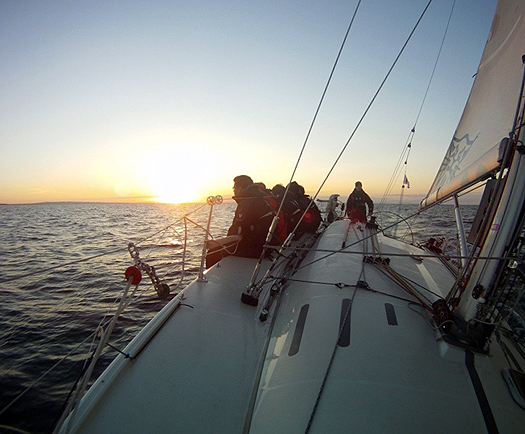
Successful debut. Dawn comes gently over the boat in winning mode in the Dun Laogaire-Dingle Race 2011
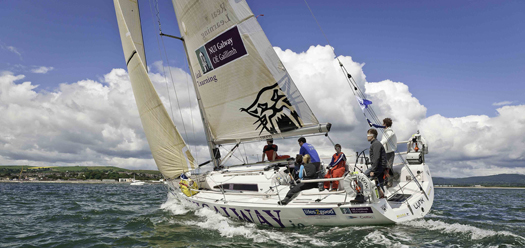
Pre-start manoeuvres off Wicklow at the 2012 Round Ireland Race
The new Breen boat made her Irish debut with the Dun Laoghaire-Dingle Race in 2011, and really stuffed it into the fleets from other Irish coasts, for she raced as Galway Harbour, and had an excellent overall win. Then last year it was active members of NUI Galway SC past and present who took her over under the leadership of Cathal Clarke, and they became the ICRA Boat of the Year with a superb all-round programme which included a class win in a major ISORA race, and the class win – including beating the hottest Reflex 38 from Britain – in the Round Ireland Race.
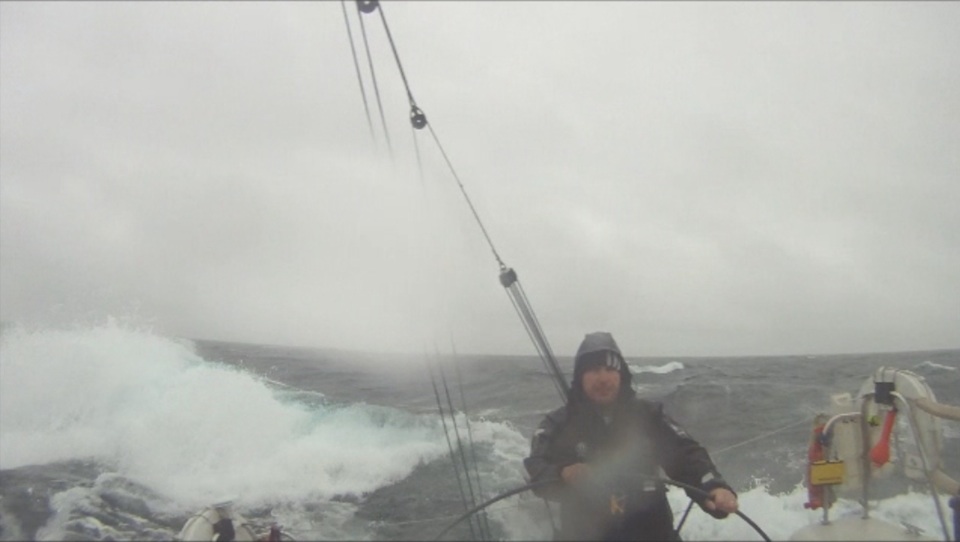
Not always sunny – determined conditions in the Round Ireland Race 2012
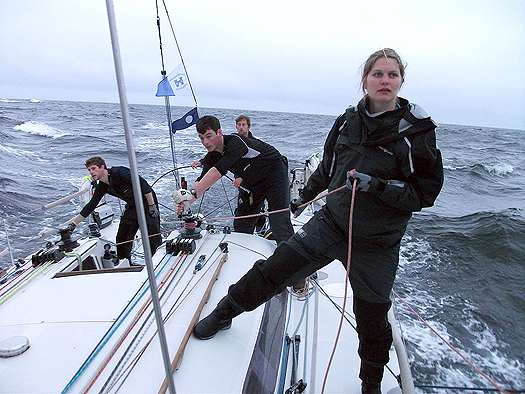
Grey day at sea, Round Ireland Race 2012, with Joan Mulloy from Mayo SC trimming the spinnaker
Between times, the boat didn't rest, as Martin Breen has his own crew for inshore regattas. But this year, the pace is into an even higher gear with Aodhan Fitzgerald (who has been involved since the boat first reached Ireland) in overall charge offshore in a programme which is simply mind-boggling. It was launched yesterday evening in Galway with the boat now in the Discover Ireland livery, and she'll be promoting the Emerald Isle and The Gathering Cruise in a series of campaigns which start today off Rinville at 1000hrs with the 60-mile Clarenbridge Crystal Race in Galway Bay. The crew will be clad from head to toe in new kit provided by Dubarry, with the boat setting a fine new set of threads from Des McWilliam, saling in conditions which look most unlikely to include any calm spots.
Then it's off to Scotland round Ireland's bumpy nor'west corner for the Scottish Series from May 24th to 27th with the boat to be raced by Martin Breen's GBSC team, then south to Dun Laoghaire to be on station for defending the Dun Laoghaire to Dingle title, starting the 266 mile course (which is also a Fastnet qualifier) on June 7th, then on from Dingle it's immediately into the WIORA and ICRA championships just round the corner at Fenit on Tralee Bay, then before June is out, they're challenging for the Sovereign's Cup in Kinsale.
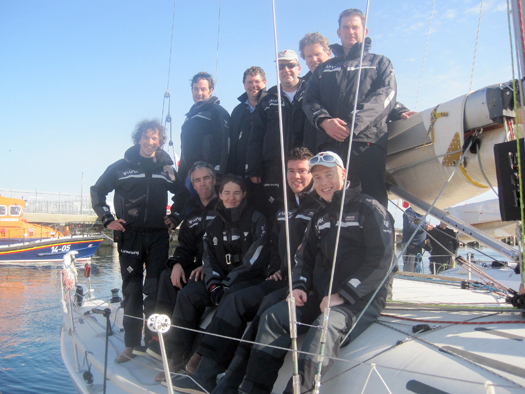
The gang's all here – the 15-strong crew panel's select offshore squad
The total crew panel is 15, ranging in age from 19 to 55, and for the offshore programme the lineup is Aodhan Fitzgerald (skipper/navigator), Johnny Murphy (tactician/trimmer), Neil Spain (driver), Ben Scallan (driver), Martin Breen (driver), Cathal Clarke (bowman), Joan Mulloy (trimmer), Nigel Moss (trimmer), Ruairi de Faoite (mast), and Louis Mulloy (bowman).
While the crew emphasis is on Connacht, in the way of offshore racing this team also includes people from most other parts of Ireland, people that you'd meet in the course of other campaigns, people who seem to fit in with your own boat's way of doing things. If you tried to delineate a clear career path on how to become part of a group like this, you'd find it very difficult. There is no clearcut way. It seems to happen by a mixture of telepathy and osmosis. You are impressed by the way people are sailing another boat, and you make it your business to get them inside your tent.
Because for sure, the business of successfully balancing different temperaments is going to be paramount in a season in which they're only getting going as the Sovereign's Cup draws to a close. The high point of the year is going to be the Rolex Fastnet Race in August. By the time the boat gets to Cowes, she'll have sailed more than a thousand miles in delivery trips.
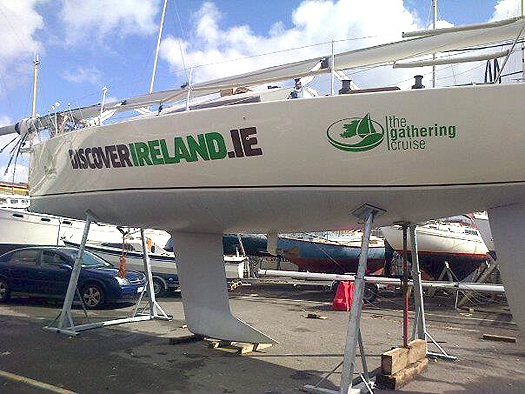
Stating the obvious? Starting the Rolex Fastnet Race with this message emblazoned on your topsides is going to invite ribald comment from the opposition. But displaying something similar has proven successful in the past.
And there she'll be in the Solent among 350 other Fastnet wannabees, with Discover Ireland boldly displayed along her topsides. They'll be getting some smartass comments about that. After all, what else is the Fastnet Race all about? Back in 1975, when the Golden Jubilee Fastnet Race included a fleet for classics racing for the Iolaire Block presented by Don Street, one splendid old gaff cutter had her crew all kitted out in crisp new T-shirts, each one imprinted with different letters. When they all lined up along the rail, those T-shirts read: "What is the way to the Fastnet Rock, please?" In Irish. And it worked. They won the Iolaire Block, even though Iolaire was herself racing. So let's hope that having discoverireland.ie emblazoned prominently on the topsides is going to be equally successful in the Fastnet Race for the boat formerly known as Lynx.
What with this extraordinary campaign, and the news this week about Galway plunging ahead with its new harbour, it's very clear that in the 21st Century, it's totally superfluous to warble on about the west being awake. For a long time now, it hasn't been asleep.
Comment on this story?
We'd like to hear from you! Leave a message in the box below or email William Nixon directly on [email protected]
WM Nixon's Saturday Sailing blog appears every Saturday on Afloat.ie
Follow us on twitter @afloatmagazine and on our Afloat facebook page


























